What is a Green roof?
A green or living roof is a layer of vegetation planted over a waterproofing system. Green roofs offer many advantages for building developers, owners and their users. They create visual enhancement of the landscape and fully exploit the spatial opportunities for visual and recreational benefit with the possibility of planning gain and, in economic terms, green roofs can have long-term financial benefits.
There are three common types of green roofs in the UK: Intensive, Extensive and Biodiverse.
The most common green roof in the UK is an Extensive green roof. It is designed for mostly aesthetic purposes, and couples a lightweight and slim design with a cost effective way to provide a client with a green roof that is not particularly suited to foot traffic.
Green roofs are becoming increasingly a prerequisite for planning approval, either through biodiversity action plans, flood risk reduction as part of sustainable drainage systems or legislation.
There are many benefits to a green roof visually, sustainably and economically, these are:
- Reduction of heat loss from the building, providing lower maintenance costs through the year
- Green roofs reduce sound exposure, deflecting sound waves over the roof and sounds transmitting through the system
- Reduce the visual impact of the building when compared to its surrounding environmentRetention of heavy rainfall.
What makes up a green roof?
SikaRoof Extensive Green Roof
SikaRoof Intensive Green Roof
SikaRoof Biodiverse Green Roof
Products and Systems
Green Roof Environmental Benefits
There are many sustainable and environmental benefits that a green roof can provide, it is important to consider what exactly are the roofs requirements of a building to ensure the right green roofing system is specified.
Enivornmental masking is created by using a green roof system where the building itself wantes to blend into its neighbouring landscape. Depending on what that landscape is, the correct system can be identified if more or deeper planting is required for the roofing system.
The installation of a green roof on a building can significantly reduce the amount of sound waves that enters the building.
A bio-diverse green roof mimics a natural habitat for different animal species improving bio-diversity.
Due to the environmental benefits of a green roof, the installation of just one helps to reduce the Urban Heat Island effect.
In the UK there is a consistent amount of rain through out the year. By installating a green roof ontop of Sika's waterproofing system, the green roof elements ensures the amount of storm water that runs off a typical roof area is managed, and therefore provides a less intense flow into surrounding gutters/drainage systems.
Thanks to the levels of thickness of the substrate in each type of green roof, the system helps to manage the flow of heat entering and leaving the roof of the building, creating a steady heat absorption system through the seasons.
As the green roof is situated on top of the waterproofing system, this layer is protected from sun providing UV protection which can prolong the life of the waterproofing system for a greater period of time.
In built up areas, green roofs can help to improve the quality of air as the living substrate absorbs atmospheric carbon dioxide and releases oxygen back in to the air around the roof.
Future Proofing Roofing
Keep up to date with Sika's Green Roof blog
Dr. Sarah Peake, Sustainability Manager at Sika UK, explores how green roofs can be used to help mitigate climate change and its effects.The fight to limit the impact of climate change is on with governments and companies alike pledging to do their part in helping to restrict global warming to 1.5°C. The construction industry has a large role to play in this with buildings that have longer lifespans considered to be more sustainable than their shorter-lived counterparts. Therefore, methods for extending a building’s expected lifespan should be carefully considered when looking towards a greener future.
Green roofs are the perfect example of a current technology that enables us to future-proof our built environment. Of course this type of roof system is already highly desirable in cities that have development action plans with an Urban Greening Factor, like London, Manchester and Birmingham. With careful consideration, green roofs can already help towards hitting government targets, such as the recently introduced Biodiversity Action Plan. Green roofs can also contribute towards an improved rating from well-respected green building programmes such as BREEAM and WELL.

